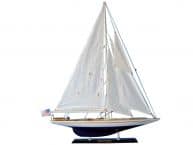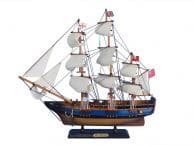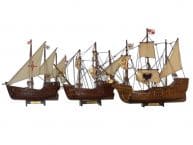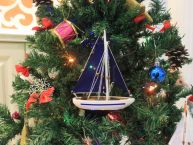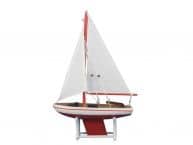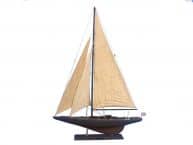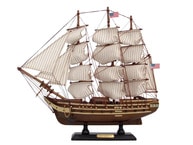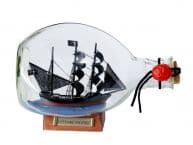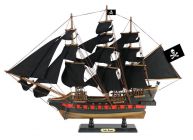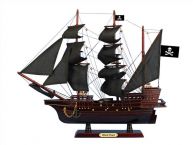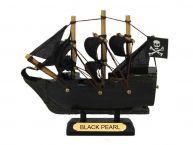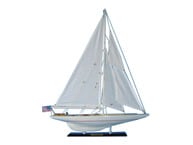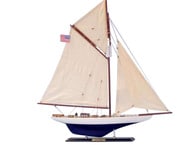NOT A MODEL SHIP KIT
Attach Sails and Bluenose model sailing yachts are Ready for Immediate Display
Inspired by the iconic Canadian schooner Bluenose, this adorable twin-masted sailing boat model is the perfect accent for any nautical themed room. Both a celebrated racing yacht and hard-working fishing boat, the Bluenose is an ideal nautical décor accent for a child’s bedroom or family living room while inspiring a proud and winning “can-do” spirit to any office or boardroom.
17" Long x 3" Wide x 14" High (1:113 scale)
- Rare high-quality woods used in building these yacht models
- Detailed Craftsmanship includes:
- Individual deck planking
- Many deck features
- Cloth sails with fine stitching
- Separate display base with metal nameplate
- Hand-painted to match the original Bluenose yacht

WARNING: This product can expose you to chemicals including Formaldehyde, and Styrene, which are known to the State of California to cause cancer, and Chromium and Toluene, which are known to the State of California to cause birth defects or other reproductive harm. For more information go to www.P65Warnings.ca.gov
Bluenose was a Canadian schooner from Nova Scotia, a celebrated racing ship (and hard-working fishing vessel) and a symbol of the province. The name "bluenose" originated as a nick-name for Nova Scotians.
Designed by William Roué and built by Smith and Rhuland, Bluenose was launched at Lunenburg, Nova Scotia on March 26, 1921, as a racing ship and fishing vessel. This was in response to the defeat of the Nova Scotian Fishing Schooner Delawana by the Gloucester fishing schooner Esperanto in 1920. That race was sponsored by the Halifax Herald newspaper.
After a season fishing on the Grand Banks, Bluenose defeated Elsie (out of Gloucester, Massachusetts), returning the trophy to Nova Scotia. During the next 17 years of racing, no challenger, American or Canadian, could wrest the International Fishermen's Trophy from her. It is notable that she was no mere racing ship, but also a general fishing craft that was worked hard throughout her lifetime. She fished scallops and other kinds of sea-food, and at least once won competitions for largest catches of the season and similar awards.
Fishing schooners became obsolete after World War II, and despite efforts to keep her in Nova Scotia, the undefeated Bluenose was sold to work as a freighter in the West Indies. She foundered on a Haitian reef on January 28, 1946.
Bluenose and her captain, Angus Walters, were inducted into the Canadian Sports Hall of Fame in 1955, making her the first and only non-human CSHF inductee until 1960, when she was joined by Canadian Hydroplane Champion Miss Supertest III. That same year another honour was bestowed upon the famous sailing ship when a new Canadian National Railways passenger-vehicle ferry for the inaugural Yarmouth-Bar Harbor service was launched as the M/V Bluenose.
Bluenose, under full sail, is portrayed on the 1929 Canadian Bluenose postage stamp as well as on two other stamps issued in 1982 and 1999 and also appears on the current Nova Scotia license plate. The depiction of a generic schooner on the Canadian dime has for years been commonly known as the Bluenose. In 2002, the government of Canada declared the depiction on the dime to be the Bluenose.


 Handcrafted
Handcrafted Handcrafted
Handcrafted Handcrafted
Handcrafted Handcrafted
Handcrafted Handcrafted
Handcrafted Handcrafted Model Ships
Handcrafted Model Ships


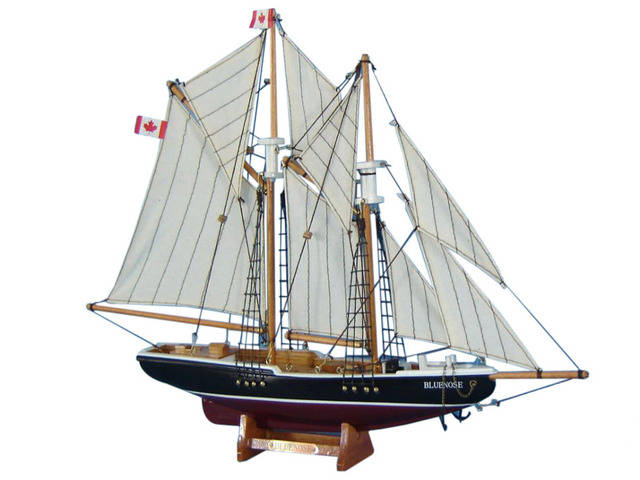

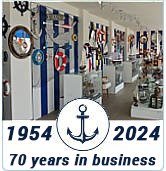






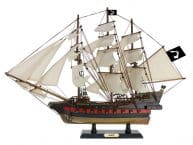
.jpg)


